August 2010
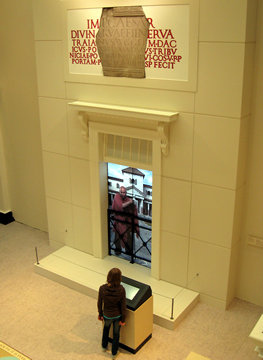
The Yorkshire Museum in the Museum Gardens opened on 1 August 2010 after a major refurbishment, and I visited a week or so later. Like the nearby library, the newly-refurbished museum seems lighter and brighter, and more ‘open’ – literally and figuratively. It is obviously designed to be more welcoming and engaging for younger people in particular, and a lot of effort has gone into opening up its assembled treasures to those who might not be excited at the thought of looking at Roman relics. Here, near the entrance, a young visitor is watching a video of a man in historic costume explaining part of the history of York.
I don’t think forty-somethings are the target audience for this kind of thing. I wandered off to look at the general reorganisation of the museum, to look down in the basement at the bits of the old abbey (a favourite bit from a previous visit) and to look for a particularly memorable and startling relic – some Roman hair.
It was rather a quick visit, as it was the school holidays and therefore rather busy. As it’s free to we Yorkies with a York Card, I’ll pop in again I think after the holidays.
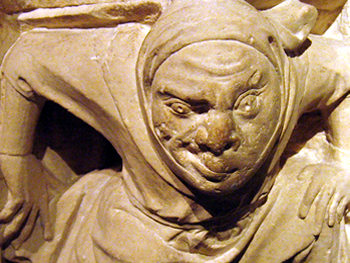
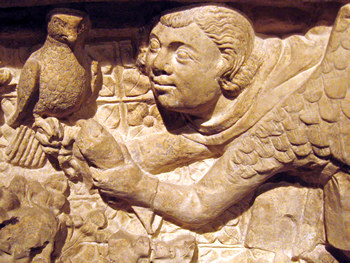
These carvings are displayed in the basement area. The figure above left is from St William’s Shrine, of 1330. The expression seems appropriate as I think I was pulling this kind of face while trying hard to concentrate on various exhibits. I’m not very good at concentrating if it’s noisy, so I’m afraid I can’t tell you what the other photo shows, except that it’s in the medieval section.
When I visited here before it was modernised I thought this section was the most memorable. It seemed to me to have lost some of the atmosphere I remembered, perhaps it’s just that it’s less gloomy, so therefore seems less authentically ‘medieval’.
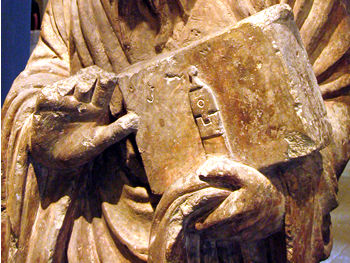
A lot of effort has gone into explaining how the exhibits in this section relate to the abbey buildings alongside.
This sculpture (detail shown left) is a statue of an apostle, dating form around 1200. His fingers have been broken over the intervening centuries, but he and several other impressive carved figures have survived, and greet you as you enter this section of the museum.
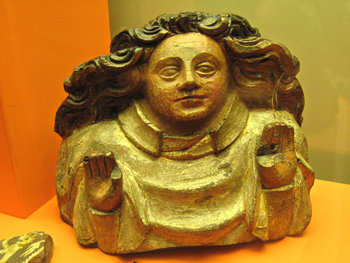
Museums can be overwhelming if you’re trying to take everything in on one visit. But there are usually one or two things which make their mark, and stand out from the vast number of exhibits you pass and look at and try to fully appreciate. I was particularly taken with this carved wooden figure, which once was part of the interior of one of my favourite York churches, St Martin le Grand on Coney Street. It’s a boss from the 15th century roof, and retains some of the paintwork which was so much a feature of medieval churches – generally lost now. Our Victorian ancestors were keen on restoring churches, and the 19th century restoration of the church resulted in the removal of some of the roof bosses, including this one.
Our Victorian ancestors also understood the value of historical artefacts, and the bosses were acquired by the Yorkshire Philosophical Society, founders of this museum. Apart from a wish to preserve historical remains, to rescue them at that time, they couldn’t have forseen what they were rescuing them from a hundred years or so later. St Martin le Grand was bombed in the Second World War, and its fittings were destroyed by fire, including the bosses still in situ.
There’s a whole five hundred years of history effectively summed up in this one exhibit.
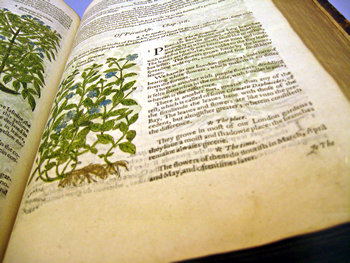
Also memorable is the reading room upstairs with its comfortable chairs and fine old volumes in glass cases, and display panels explaining the history of the museum and its founders. This fabulous huge old weighty tome has a botanical theme. It’s open at a page on the Periwinkle plant. Under the heading ‘The place’ it reads: ‘They growe in most of our London gardens & they love a moist and shadowie place: the branches remaine alwaies greene.’ Then under another heading – ‘The time': ‘The flowers of them do flourish in March, April and May, and oftentimes later.’ This plant is still well-known and widely-grown now, but unfortunately our 21st century gardening books no longer contain such charming turns of phrase as ‘the flowers of them do flourish’.
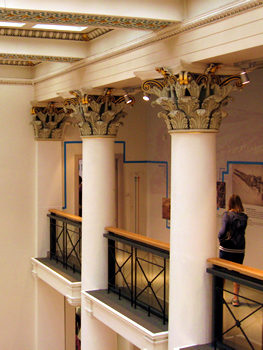
Just as the library refurbishment highlighted architectural features which had been forgotten or obscured by rather ‘functional’ decorative treatment in the 20th century, so the redecoration here in the museum brings architectural details to prominence. These exuberant Corinthian columns were presumably here before, but I didn’t notice them on a previous visit. The details have been beautifully accentuated with paintwork. I don’t envy the people who had to paint these intricate leafy bits.





Thank you for adding a comment. Please note that comments are moderated, but should appear within 24 hours.